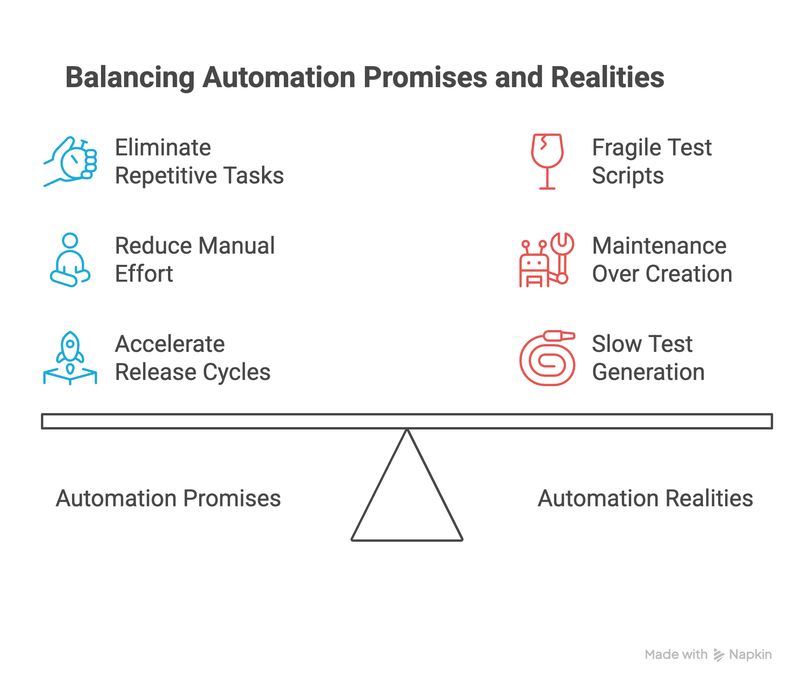As software teams race to release features faster than ever, quality assurance (QA) often ends up playing catch-up. While CI/CD pipelines have streamlined development and deployment, QA tools and workflows remain stuck in legacy modes of operation. Traditional automation, with all its promises, still struggles under the weight of flaky scripts, brittle test cases, and high maintenance overhead.
But there's a new wave on the rise: autonomous QA agents. And leading this shift is Aurick.ai, a platform redefining how teams approach testing.
Why Traditional QA Automation Is Cracking
Automation was supposed to be the fix. It promised to eliminate repetitive testing tasks, reduce manual effort, and accelerate release cycles. But the reality has been more sobering.
Test scripts are fragile. A simple change to a UI component can cause an entire suite to break. According to a report by Capgemini, nearly 61% of QA teams cite maintenance as a top pain point in their automation strategy. The result? Teams spend more time maintaining tests than writing new ones.
Regression cycles are bloated with redundant checks, often missing the areas where bugs actually hide. Risk prioritization is manual. Test case generation is slow and reactive. And in a world where speed is survival, this approach just doesn’t cut it.
Enter the Autonomous QA Agent
AI in testing isn’t new. Tools have emerged over the last decade that leverage AI to assist testers—be it through test generation from requirements or smarter element selectors. But there's a stark difference between AI-assisted testing and truly autonomous QA.
Autonomous QA agents, like Aurick.ai, operate end-to-end. They don’t just assist—they act. They explore your application like a user, generate meaningful test cases, execute those tests, and report issues with full context: logs, browser screenshots, and reproduction steps.
This isn’t science fiction. According to a research paper published on arXiv, large language models are now capable of not just interpreting code and UI states, but also generating exploratory test scenarios and executing them independently.
Aurick takes this one step further. It adapts to UI changes in real time, mimics real user flows, and integrates seamlessly with your CI/CD setup—reducing the QA workload by up to 80%.
Beyond Automation: Toward Agentic Testing
The shift is subtle but powerful. Traditional automation requires humans to direct the system—write the scripts, define the paths, maintain the flows. Autonomous agents work with intent.
Instead of treating tests as static scripts, Aurick approaches them as dynamic conversations with the product. It identifies risks based on product changes, prioritizes them, and tests accordingly. This is the move from automation to orchestration.
In a recent dev.to article, QA leaders discussed how AI agents are becoming active participants in the software lifecycle—not just passive tools. They’re evolving to be cognitive testers that grow smarter with every interaction.
Challenges and Tradeoffs
No technology is a silver bullet. Autonomous QA tools still rely heavily on data quality. Without diverse, high-quality test histories, even the most sophisticated AI can make incorrect assumptions. Interpretability remains another concern—understanding why a test failed and what an AI agent "thought" is still an evolving space.
However, platforms like Aurick are tackling these head-on, building transparency layers into their reporting. Instead of just flagging a failed test, Aurick shows you the exact interaction that broke and explains its rationale for the flow it chose.
The Future Is Already Here
As we step into an era of agentic AI, QA isn’t being replaced—it’s being upgraded. Human testers are free to focus on strategy, edge cases, exploratory testing, and user empathy. The grunt work—setup, execution, documentation—is handled by your AI teammate.
Aurick.ai represents this shift. It’s not a tool; it’s a teammate. One that clicks buttons, fills forms, catches bugs, and never complains about flaky selectors. For teams shipping at high velocity, it’s not just nice to have—it’s essential.
If QA still feels like a bottleneck, maybe it’s time to stop asking your humans to work like robots—and let Aurick do the repetitive parts.
Learn more about how Aurick is redefining QA at aurick.ai.




Top comments (0)